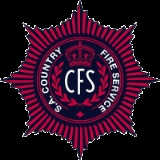
Country Fire Service
Encyclopedia
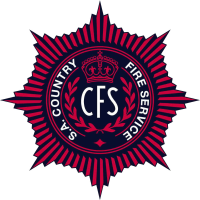 The CFS Badge | |
| Established: | 1976 |
|---|---|
| Regions: | 6 |
| Specialities: | Combatant Authority for Fire Fire Fire is the rapid oxidation of a material in the chemical process of combustion, releasing heat, light, and various reaction products. Slower oxidative processes like rusting or digestion are not included by this definition.... , Rescue Rescue Rescue refers to responsive operations that usually involve the saving of life, or prevention of injury during an incident or dangerous situation.... and Hazmat |
| Volunteers: | ~15,500 |
| Paid Staff: | 109 |
| Brigades: | 434 |
| Location: | South Australia South Australia South Australia is a state of Australia in the southern central part of the country. It covers some of the most arid parts of the continent; with a total land area of , it is the fourth largest of Australia's six states and two territories.South Australia shares borders with all of the mainland... |
| Current CO: | Greg Nettleton |
| Website | Official CFS Website |
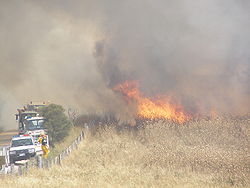
South Australia
South Australia is a state of Australia in the southern central part of the country. It covers some of the most arid parts of the continent; with a total land area of , it is the fourth largest of Australia's six states and two territories.South Australia shares borders with all of the mainland...
in Australia
Australia
Australia , officially the Commonwealth of Australia, is a country in the Southern Hemisphere comprising the mainland of the Australian continent, the island of Tasmania, and numerous smaller islands in the Indian and Pacific Oceans. It is the world's sixth-largest country by total area...
. Many parts of Australia are sparsely populated whilst at the same time they are under significant risk of bushfire. Due to economics, it is prohibitively expensive for each Australian town or village to have a paid fire service (department). The compromise adopted is to have government funded equipment and training but volunteer fire-fighters to perform the duties of regular fire-fighters.
In South Australia, the name for the volunteer service is the CFS. Other Australian States and Territories have their own service, such as the Country Fire Authority
Country Fire Authority
Country Fire Authority, or CFA, is the name of the fire service that provides firefighting and other emergency services to all of the country areas and regional townships within the state of Victoria, Australia, as well as large portions of the outer suburban areas and growth corridors of Melbourne...
in the state of Victoria
Victoria (Australia)
Victoria is the second most populous state in Australia. Geographically the smallest mainland state, Victoria is bordered by New South Wales, South Australia, and Tasmania on Boundary Islet to the north, west and south respectively....
and the Rural Fire Service in the state of New South Wales
New South Wales
New South Wales is a state of :Australia, located in the east of the country. It is bordered by Queensland, Victoria and South Australia to the north, south and west respectively. To the east, the state is bordered by the Tasman Sea, which forms part of the Pacific Ocean. New South Wales...
.
In the state capital Adelaide
Adelaide
Adelaide is the capital city of South Australia and the fifth-largest city in Australia. Adelaide has an estimated population of more than 1.2 million...
, a conventional paid service exists, called the SA Metropolitan Fire Service
Metropolitan Fire Service
The South Australian Metropolitan Fire Service is South Australia's government-funded fire service.The South Australian Fire Brigade was formed in 1882, following passing of the Fire Brigades Act.In 1981 the service was renamed to SAMFS when it became government funded.The MFS has 35 fire stations...
(SAMFS). A handful of large towns in South Australia also have retained 'Metro' or 'MFS' services, but the vast majority (over 430 communities) rely on the CFS. Several Adelaide suburbs that retain extensive scrubland have CFS stations whose area of operation overlaps that of the SAMFS with joint training exercises sometimes organised for major community facilities such as the Flinders Medical Centre
Flinders Medical Centre
Flinders Medical Centre is a 580 bed public teaching hospital and medical school, co-located with Flinders University and the 130 bed Flinders Private Hospital located at Bedford Park, South Australia. It opened in 1976. It is one of the major public hospitals operating in metropolitan Adelaide...
. For urban incidents, both services will often attend with the first arrival taking command.
About the CFS
The SA Country Fire Service (SACFS) is the volunteer combatant authority for firefighting, road crash, and hazardous materials in the country region of South AustraliaSouth Australia
South Australia is a state of Australia in the southern central part of the country. It covers some of the most arid parts of the continent; with a total land area of , it is the fourth largest of Australia's six states and two territories.South Australia shares borders with all of the mainland...
(SA). Their official mission is "To protect life, property and the environment from fire and other emergencies whilst protecting and supporting our personnel and continuously improving."
A unique look
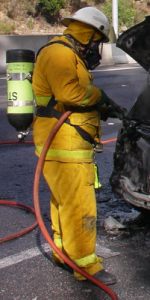
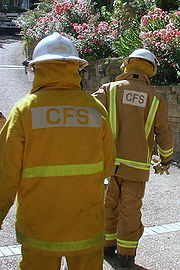
Battenburg markings
Battenburg refers to a pattern of high-visibility markings used to maximise conspicuity, primarily used on vehicles of the emergency services, but also in other applications such as uniforms...
with bright chevrons on the rear of the appliances.
Fire fighters wear yellow protective clothing, with a two-piece set being the standard (Bunker pants, and turn out coat). With the introduction of PBI Gold (improved structural fire-fighting clothing), some CFS volunteers are now seen wearing yellow/brown coloured clothing. Most turn out coats have "CFS" or "FIRE" on the back in reflective writing. More modern jackets also have day/night striping around the sleeves and bottom of the jacket. Safety Vests are provided for work on the roads. these have "Fire", "Rescue", or "CFS" on both front and back in reflective writing.

Regional staff have a blue stripe on their helmet.
CFS History
In colonial times, the government attempted to control the outbreak of wildfires by legislating against the careless use of fire. This began with the 1847 ordinance against reckless burn-offs of stubble and grass. The challenge of fire suppression was left to local residents who would band together to fight fires without any formal organization or authority. In 1913, district councils were given the right to appoint fire control officers given the power to do anything 'necessary or expedient and practicable' to prevent fires or to protect life and property.As firefighting technology advanced during World War II, a government-equipped volunteer Emergency Fire Service (EFS) brigade was established in Adelaide followed by additional brigades in some country areas. After the war, equipment from these brigades was lent to district councils for rural firefighting work. To supervise the program, an Emergency Fire Services division was formed as a division of the police department.
Throughout the mid-1950s, the EFS grew stronger and more organized, and volunteers began to campaign for the establishment of the EFS as a statutory authority. This was achieved in 1976 with the passing of the Country Fires Act through the South Australian Government which retitled the EFS as the County Fire Service (CFS). The Country Fires Act, 1989 pulled the control of the CFS away from district councils to the State Government, allowing for the development of a standardised service able to respond quickly to emergencies across South Australia
South Australia
South Australia is a state of Australia in the southern central part of the country. It covers some of the most arid parts of the continent; with a total land area of , it is the fourth largest of Australia's six states and two territories.South Australia shares borders with all of the mainland...
. In the late 1990s, as part of a drive to ensure that the CFS was properly equipped, another major change in funding was brought in, and the administration of the Service was combined with the administration of several other emergency services.
Today, the Emergency Services Levy Funding provides for the training, equipment and administration resources required to maintain the operation of the Service, but the CFS still stands fundamentally on the commitment and energy of its volunteers.
In 2005 the South Australian Fire and Emergency Services Commission (SAFECOM) Act was passed in South Australian Parliament. This act brings the Country Fire Service (SACFS) Metropolitan Fire Service
Metropolitan Fire Service
The South Australian Metropolitan Fire Service is South Australia's government-funded fire service.The South Australian Fire Brigade was formed in 1882, following passing of the Fire Brigades Act.In 1981 the service was renamed to SAMFS when it became government funded.The MFS has 35 fire stations...
(SAMFS) and South Australian State Emergency Service
State Emergency Service
A State Emergency Service is an Australian volunteer organisation that provides emergency help during and after declared disasters. The SES is also the primary or secondary agency for emergencies, such as storm damage,flood damage, building damage, traffic hazards and road crash rescue...
(SASES) together under one administration board, and funding source. Vince Monterola, CEO of the Country Fire Service at the time, was appointed as the inaugural chairman. It is this Act that defines the Country Fire Service (CFS) as the South Australian Country Fire Service (SACFS). The SAFECOM Act of 2005 replaces the Country Fires Act of 1989, the South Australian Metropolitan Fire Service Act of 1936 and the State Emergency Service Act of 1987.http://www.parliament.sa.gov.au/Catalog/legislation/Acts/f/2005.40.un.htm
Divisions

The CFS is made up of brigades which are organised into groups, which are again grouped into Regions. There are six regions in SA, and 55 groups. The CFS consists of around 434 brigades and 16,400 volunteers (11,800 fire fighters, 3,400 Auxiliary and 1000 cadets).
Strike teams
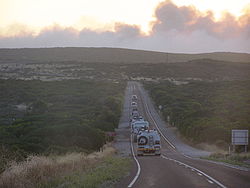
Along a similar line task forces are groups of appliances that are mobilised to combat a particular incident out of their usual area of operation. However task forces are more flexible in their makeup and appliances are usually specifically selected for a particular incident. Where practical the 1 leader with 5 subordinates ratio is maintained for command ability. Task forces attend a wide range of incidents including flooding.
There are also regional strike teams. These strike teams are put together when there are high fire danger days coming up and the CFS does not want to stretch a group's resources. These regional strike teams usually have one or two trucks from a few groups in that region. They sometimes have two or more commanding cars, plus a State Emergency Service
State Emergency Service
A State Emergency Service is an Australian volunteer organisation that provides emergency help during and after declared disasters. The SES is also the primary or secondary agency for emergencies, such as storm damage,flood damage, building damage, traffic hazards and road crash rescue...
vehicle for logistics.
Chain of command
The CFS chain of command is set out in the following way, with the top being the most senior in rank:- Chief Officer (Red helmet with a white stripe)
- Deputy Chief Officer (Red helmet with a white stripe)
- Assistant Chief Officer (Red helmet with a white stripe)
- Commander / Regional Commander (Red helmet with a blue stripe)
- Staff/Regional Officer (Red helmet with a blue stripe)
- Group Officer (Red helmet)
- Deputy Group Officer (Red helmet)
- Brigade Captain (Yellow helmet with a red stripe) is the most senior rank in a brigade and he or she is responsible for the operational and administrative aspects of the brigade. The position is elected by members of the brigade. Some of the things that a Captain will do are: undertaking responsibility for the proper management and maintenance of brigade property and equipment, ensuring members of the brigade are properly trained, take command of incidents and ensure that the chain of command within the brigade operates effectively, assisting with bushfire prevention and planning within the brigade's response area, liaising with other captains in adjacent brigades and managing the operations of the brigade in accordance with any determination of the CFS board.
- Brigade Lieutenant. (Yellow helmet) There must be at least two Lieutenants in a brigade and a maximum of four. They are elected to assist the captain in the performance of his or her functions, and take over in the absence of the Captain.
- Senior Fire Fighter. (White helmet with a red stripe) Seniors are not officers as such, but assist the Captain and Lieutenants with mainly operational management. They should be experienced personnel within the brigade, and they provide an opportunity for brigades to establish a line of middle management or succession planning. Some people see the position of a Senior as a build up to becoming a Lieutenant.
- Fire Fighter (White helmet) is the lowest rank of operational fire personnel, but they are the most important, because they make up the numbers. These fire-fighters can be trained just as much as a more highly ranked person but they do not usually take a leadership role at an incident.
- Cadet. (White helmet with "cadet" sticker) The age in which you can become a cadet is 11, but some brigades will set higher minimum ages for their members. At the age of 16 you are able to choose to become a fire-fighter, or stay on until you are 18 as a cadet. Cadets are taught skills which will help them when they become fire-fighters.
- Auxiliary brigade member. (no helmet) They do not go out on the fire truck. They help out with any of the other jobs that need doing, including fundraising, preparing food, operating the station radio etc.
All positions from Group Officer down (inclusive) are voluntary and are elected democratically by fire-fighters (with the exception of cadets).
Regional Officers and above are appointed by the state government.
Other positions that may be held within a brigade are:
- Brigade Communications Officer is responsible for ensuring all communication equipment is operational and utilised correctly and efficiently.
- Brigade Training Coordinator coordinates training, including weekly training and ensuring volunteers are placed on appropriate specialist courses.
- Brigade Logistics Support Officer provides logistics support at a local level, e.g. food packs on appliances, and resource directories in the radio room.
- Brigade OH&S Coordinator ensures OH&S requirements are met, and near miss and accident report forms are lodged appropriately.
- Brigade Administration Officer does administration, including signing up of new members.
Chief Officer
- Greg Nettleton as of January 24, 2011.
- Euan Ferguson since 2001. Announced resignation 30th Sept 2010 to take the role of Chief Officer of the CFA
Director
- Donald Macarthur (1985–1994)
- Lloyd Johns (1979–1984)
- Fred Kerr (1977–1979, and EFS Director from 1949)
Star logo

Brunswick star
The Brunswick star is an emblem which in outline is an eight-pointed or sixteen-pointed star, but which is composed of many narrow rays. It is used in Britain to surround the Royal Cypher on various badges, such as that worn on the caps and helmets of almost all police forces...
logo is used as the official badge of the SA Country Fire Service. It is claimed to have originated from the Maltese Cross
Maltese cross
The Maltese cross, also known as the Amalfi cross, is identified as the symbol of an order of Christian warriors known as the Knights Hospitaller or Knights of Malta and through them came to be identified with the Mediterranean island of Malta and is one of the National symbols of Malta...
, the emblem of the Knights of Malta, which was used by the Knights of Saint John of Jerusalem at the time of the Crusades. The points or tenets were said to represent the knightly virtues of tact, loyalty, dexterity, observation, sympathy, explicitness, gallantry and perseverance. Since these virtues represent the qualities required by a firefighter, the star was chosen for the insignia of the CFS.
Each point of the Star represents a virtue, valued in a fire fighter. these are (from top point, going clock-wise)
- Tact
- Loyalty
- Dexterity
- Observation
- Sympathy
- Gallantry
- Explicitness, and
- Perseverance
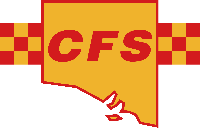
The corporate logo
The new corporate logo was introduced in 1999, in an effort to present the modern image of the CFS as a professional organisation. The logo should be used on fire appliances, fleet vehicles, helmets and official CFS publications. The logo was chosen as a result of a competition and is based on a design by a CFS volunteer, Gary MacRae. The red checker pattern representing the fire service, the yellow representing the colour of the CFS turn-out gear, and the map of south Australia representing the area served.Dispatch
The CFS has a few ways of dispatching brigades to emergencies, however in almost all, pagers are used to alert volunteers to the incident. People wanting to report an incident should ring the national emergency number 000, (or 112Emergency telephone number
Many countries' public telephone networks have a single emergency telephone number, sometimes known as the universal emergency telephone number or occasionally the emergency services number, that allows a caller to contact local emergency services for assistance. The emergency telephone number may...
from a mobile phone), and ask for 'fire'. Their call will be taken by trained operators at the SAMFS
Metropolitan Fire Service
The South Australian Metropolitan Fire Service is South Australia's government-funded fire service.The South Australian Fire Brigade was formed in 1882, following passing of the Fire Brigades Act.In 1981 the service was renamed to SAMFS when it became government funded.The MFS has 35 fire stations...
communications centre. Brigades can also be responded by notifying a brigade in person, or by ringing the local brigade's phone (if the station is manned). If they ring the local fire brigade's emergency number, they will be put through to the ALERTS system, which sets up a teleconference with brigade members, as well as a call taker at SAMFS. Using the 000 emergency number is recommended.
As of July 2007, all dispatch and day-to-day state operations were relocated to the SAMFS
Metropolitan Fire Service
The South Australian Metropolitan Fire Service is South Australia's government-funded fire service.The South Australian Fire Brigade was formed in 1882, following passing of the Fire Brigades Act.In 1981 the service was renamed to SAMFS when it became government funded.The MFS has 35 fire stations...
communications centre. SAMFS
Metropolitan Fire Service
The South Australian Metropolitan Fire Service is South Australia's government-funded fire service.The South Australian Fire Brigade was formed in 1882, following passing of the Fire Brigades Act.In 1981 the service was renamed to SAMFS when it became government funded.The MFS has 35 fire stations...
are now the lead agency undertaking dispatch for MFS, CFS and SES.

Responsibility
In addition to special services such as floodFlood
A flood is an overflow of an expanse of water that submerges land. The EU Floods directive defines a flood as a temporary covering by water of land not normally covered by water...
damage, and weather damage (e.g. trees over roads), the CFS responds to three main incident types.
Motor vehicle accident (MVA) spillages, and Road Crash Rescue (RCR)
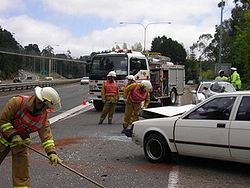
The Country Fire Service often performs these duties with the assistance of other agencies. Such as the Metropolitan Fire Service
Metropolitan Fire Service
The South Australian Metropolitan Fire Service is South Australia's government-funded fire service.The South Australian Fire Brigade was formed in 1882, following passing of the Fire Brigades Act.In 1981 the service was renamed to SAMFS when it became government funded.The MFS has 35 fire stations...
(SAMFS), State Emergency Service
State Emergency Service
A State Emergency Service is an Australian volunteer organisation that provides emergency help during and after declared disasters. The SES is also the primary or secondary agency for emergencies, such as storm damage,flood damage, building damage, traffic hazards and road crash rescue...
(SES), South Australian Police (SAPOL), the South Australian Ambulance Service (SAAS) and Water Operations (Volunteer Coast Guard, SES, F MAS, life saving or Sea Rescue).
Fire fighting
Fire fighting is the main job of the CFS. They respond to any fires including country and urbanUrban area
An urban area is characterized by higher population density and vast human features in comparison to areas surrounding it. Urban areas may be cities, towns or conurbations, but the term is not commonly extended to rural settlements such as villages and hamlets.Urban areas are created and further...
. Fire fighters combat grass fires, bush fires, crop fires, scrub fires, haystack fires, and brush fence fires, house fires, chimney fires, car fires, rubbish bin fires etc. Most trucks carry breathing apparatus, and use foam as a fire fighting agent.
The CFS's specialty is the containment, control and extinguishing of bushfires (wildfires). This can be via offensive or defensive methods of attack. Also with the aid of water bombers (Crop duster type fixed-wing aircraft and helicopters). While Fire-fighters will never put themselves into an overly dangerous situation, (the Dead Man Zone
Dead Man Zone
The Dead Man Zone is defined as the area directly around a bushfire that is likely to burn within five minutes given the current wind conditions or an anticipated change in wind direction...
) they will attack the fire as quickly and as directly as possible.
Fire fighting can be done in several ways:
- As a direct attack,
- A head attack (the front of the fire is attacked. Only suitable for small, or slow moving fires)
- A flank attack. (The most common method. The fire is extinguished along its flanks, starting at the back, and working forward, until you have pinched the fire out).
- As an indirect attack
- Back BurnBackfireThe word backfire in general use usually refers to a plan where the opposite of the desired effect happens or the perpetrator is directly affected as opposed to their intended target.In economics, backfire is described in terms of:* the Jevons paradox...
ing (Light a smaller fire in front of the main front, so that when the main front arrives, there is no fuel left to burn.) - Using mineral earth breaks (Using bulldozers, or rakehoeRakehoeA rakehoe is a tool used by wildland firefighters that is half rake and half hoe.The two tools are combined on the same end, so that they are on the same sheet of metal. The rake is very coarse, so can only be used for raking coarse material. The hoe is a flat blade, that can be used to scrape and...
s to clear fuel from the path of the fire) - Leaving a fire to burn itself out, while monitoring its perimeter.
- Back Burn
Special service
The CFS is the combatant authority for HAZMAT (hazardous materials) incidents. However, not all brigades respond to these. As HAZMAT incidents require a lot of people, only about 1 in 10 brigades are HAZMAT trained, and resources are drawn from all over the state. The CFS is the only authority in country South Australia that is equipped to deal with hazardous material spillages.Urban fringe brigades also do "Enhanced Mutual Aid" with the SA Metropolitan Fire Service. This involves change of quarters to metropolitan stations and responding to incidents in the metropolitan area.
Appliances
The CFS has 5 types of appliances: urban appliances, rural appliances, specialised appliances, Combinations of all three and water bombers.Rural appliances
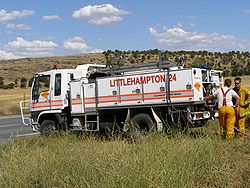
These rural appliances are extremely important for keeping South Australia protected from fires. Almost every town in South Australia would have at least one of these rural fire trucks. The reason that there are many different types of rural trucks, is because the terrain changes a lot in South Australia. A 14 appliance, only carries 1000 litres nominally (often 600L usable), but is extremely useful for getting into small tracks which larger appliances can not. Large 34s often have trouble in getting into smaller areas. 24s are the most common, because they are not too heavy and big, but carry a reasonable amount of water, which can last a good time before having to fill up. In most parts of South Australia outside major centres there is no water mains, so this is where Bulk Water Carriers come in handy. These BWCs, often at a rural fire, will be stationary at the edge of it, for smaller trucks to fill up from. when empty it is their job to go and find water in places including, rivers, dams, swimming pools and water tanks.
Urban appliances
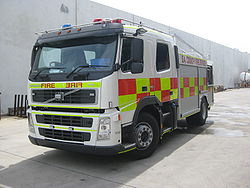
Specialised appliances
These are trucks which are designed for one purpose, like Rescue, or HAZMAT. Usually these are combined with another truck. (e.g. A pumper will be a combined Pumper/HAZMAT truck, or Pumper/Rescue) There is one state-wide HAZMAT truck, which is based at Burnside CFS that responds to any HAZMAT incident in the state. It carries extra air cylinders for the Breathing Apparatus as well as gas tight suits, atmospheric monitoring equipment, and other specialised equipment.According to the Basic Fire Fighting 1 (BFF1) manual, the CFS vehicles are such:
- 73 Urban appliances
- 515 Rural Appliances
- 7 Multi purpose appliances
- 1 state HAZMAT response appliance
- 71 Command vehicles
- 11 RescueRescueRescue refers to responsive operations that usually involve the saving of life, or prevention of injury during an incident or dangerous situation....
Vehicles - 17 Tankers
- 150 Miscellaneous transport vehicles
Skills Training
The CFS pays for all its volunteers to be trained to the required level. It has a world class training centre at BrukungaBrukunga, South Australia
Brukunga is a small town in the Adelaide Hills, located approximately 40 km east of Adelaide and 4 km north of the town of Nairne. At the 2006 census, Brukunga had a population of 579....
, in the Adelaide Hills
Adelaide Hills
The Adelaide Hills are part of the Mount Lofty Ranges, east of the city of Adelaide in the state of South Australia. It is unofficially centred on the largest town in the area, Mount Barker, which has a population of around 29,000 and is also one of Australia's fastest growing towns.- History :The...
, where the specialised courses are held. However, some courses are trained by other services or companies, like first aid, given by St Johns. There is another training centre, called the south coast training centre, but it is not as well equipped, nor funded. Here is a list of some of the courses available.

- Basic Fire Fighting 1 (BFF1) (Basic training course) (Nationally accredited)
- Suppress Wildfire (Level 2) (Nationally accredited)
- Level 3 (new course out soon, which is nationally accredited)
- Plantation Fire Fighting
- Operate Breathing Apparatus Open Circuit (Nationally accredited)
- Compartment Fire Behaviour (Nationally accredited)
- Hazmat (Nationally accredited)
- Road crash rescue (Nationally accredited)
- Senior First Aid
- Advanced Resuscitation
- Rope Rescue (Nationally accredited)
- AIIMS incident management (Nationally accredited)
- Leadership
- Navigate in Urban and Rural Environments
- Global Positioning Systems Instructor
- Leadership (Nationally accredited)
- SPAM (Stress Prevention And Management)
- Train Small Groups
- Flammable Liquids (FL)/ Liquid Petroleum Gas (LPG) Workshop
- Atmosphere Monitoring
Weekly Training
Most urban stations have a weekly training, the time of this training differs between brigades. (Some brigades opt to have 2 training days a week, so that all members can attend). In this training time CFS members will revise skills which they have learnt in skill training. This training time is also used for organisation and maintenance. Below is a list of common things that happen on Training nights.
- Testing of equipment
- Pumps, pumping and draughting
- Social Games with other brigades
- Map reading, and navigation
- Communication skills
- Mock Search and Rescue
- Vehicle and station maintenance
- Fitness tests
- Mock Vehicle accidents
- Mock running grass fire
- Other mock incidents
See also
- Ash Wednesday firesAsh Wednesday firesThe Ash Wednesday bushfires, known in South Australia as Ash Wednesday II, were a series of bushfires that occurred in south-eastern Australia on 16 February 1983. Within twelve hours, more than 180 fires fanned by winds of up to 110 km per hour caused widespread destruction across the states...
- Eyre Peninsula BushfireEyre Peninsula bushfireIn January 2005, Eyre Peninsula, South Australia, was the scene of a devastating bushfire in which nine people were killed and at least 113 injured. It was one of Australia’s worst bushfires since the Ash Wednesday fires of 1983....
, 2005 - Emergency Fire Service (The CFS before 1979)
- Metropolitan Fire ServiceMetropolitan Fire ServiceThe South Australian Metropolitan Fire Service is South Australia's government-funded fire service.The South Australian Fire Brigade was formed in 1882, following passing of the Fire Brigades Act.In 1981 the service was renamed to SAMFS when it became government funded.The MFS has 35 fire stations...
(SAMFS, South Australia) - Country Fire AuthorityCountry Fire AuthorityCountry Fire Authority, or CFA, is the name of the fire service that provides firefighting and other emergency services to all of the country areas and regional townships within the state of Victoria, Australia, as well as large portions of the outer suburban areas and growth corridors of Melbourne...
(CFA, Victoria) - New South Wales Rural Fire ServiceNew South Wales Rural Fire ServiceThe New South Wales Rural Fire Service is a volunteer-based firefighting agency and statutory body of the NSW Government. The NSW RFS is responsible for the general administration of rural fire management affairs including administration of the Rural Fire Fighting Fund, co-ordination with local...
(RFS) - Fire and Emergency Services Authority of Western AustraliaFire and Emergency Services Authority of Western AustraliaThe Fire and Emergency Services Authority of Western Australia is a statutory government authority created in January 1999 to administer the following legislation within the state of Western Australia:...
(FESA)

